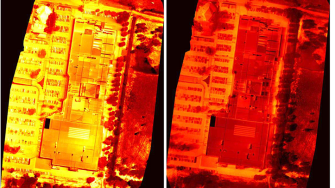
The aim of the project was to develop evidence-based cool roof design and cost-benefit calculation resources, mainly focused on large-footprint buildings, and specifically tuned to the needs of Australian industry, namely covering Australian climate zones, building typologies, construction details, locally produced cool roof products, etc.
Project Aim (and/or Objectives)
Cool roof technology is known to reduce the cooling energy consumption of conditioned buildings during hot periods and widespread implementation of such roofs in a neighbourhood or precinct can mitigate the urban heat island effect. Established building energy modelling techniques are able in principle to predict the benefits of cool roofs due to reduced heat transfer through the roof structure. But several scientific and industry publications have claimed that additional benefits can arise from reducing air temperature above cool roofs. Rooftop heating, ventilation and air-conditioning (HVAC) equipment energy consumption would be reduced by such an effect and the efficiency of rooftop photovoltaic (PV) panels would be improved. This study summarises the work carried out under project RP1037 (an activity carried out under the auspices of the Cooperative Research Centre for Low Carbon Living, under Program 1: Integrated Building Systems), the aim of which was to help overcome a number of barriers that were hindering the wide-scale utilisation of cool roof technology on Australian large-footprint buildings.
The evidence base and resources developed will allow designers/owners to easily, but rigorously, quantify the costs and benefits of cool roof products from the point of view of both ‘passive’ reduction of heat load through the roof and from the above-roof temperature field, which may cause HVAC plant located on the roof to consume significantly more energy than when a cool roof is employed.
Figure 1. Comparison of thermal and visible images of PV panels
Method
- A comprehensive review of relevant literature.
- In-situ monitoring of three case study large-footprint buildings.
- Detailed point-in-time monitoring at the three case study buildings.
- Comparison of various computational fluid dynamics (CFD) techniques, using test cases from the experimental campaign.
- Development of an accurate and robust model for the estimation of above-roof temperatures in building performance simulations (BPS).
- Generation of a rigorous evidence base, quantifying air temperatures above large footprint buildings.
- Conducting a comprehensive BPS study, taking into account the effects of the above-roof temperature field on rooftop equipment.
- Application of theoretical year-round building energy consumption data, from the BPS study, in a cost-benefit analysis of cool roof technology in new-build and retrofit scenarios.
Figure 2. Side-by-side comparison of a non-cool (SR = 0.47) and a cool-coated roof (SR = 0.61)
Figure 3. Schematic outline of the project activities
Project outcomes
Building Performance Simulations (BPS) were conducted for two case-study large-footprint buildings, in seven Australian climate zones, with four different roof materials and two different HVAC systems. Research case study buildings represented a simplified airport and a shopping centre, and were simulated with and without above-roof temperature model.
- The airport required more than twice the thermal energy and tended to require proportionally more cooling than the shopping centre did.
- The heating/cooling ratio varied from 0.0 (airport in climate zone 1) to 2.81 (shopping centre in climate zone 7).
- Cool roofs were observed to reduce annual electricity consumption and increase annual gas consumption in all cases by an average of 4.0% and 8.4%.
- The effects of the cool roof were consistently increased by above-roof effects.
- The effects of cool roofs on near-roof air temperatures, and the consequential effects of these temperatures on the performance of rooftop HVAC equipment, need to be considered for accurate predictions of cool roof performance relative to ‘non-cool’ roofs.
- One of the limitations of the research was the number of buildings typologies and the range of design and occupancy details simulated. Furthermore, the simulations were conducted with only a limited set of radiative-optical properties, representing some common roof types.
- The results of the present study should be treated as indicative values, representing two example buildings with specific roof properties at a point in time.
- Despite the sensitivities and limitations noted above, the effects of cool roofs and the relative importance of above-roof temperature effects have been demonstrated to be very significant for the large-footprint building types studied.
Project Participants
Project leader: Scientia Prof. Mattheos Santamouris
Research team: Alan Green, Laia Ledo Gomis, Afroditi Synnefa, Shamila Haddad, Riccardo Paolini, Paul Cooper, Jamie Adams, Mark Eckermann, Greg Johnson, Georgios Kokogiannakis, Zhenjun Ma, Buyung Kosasih and Mattheos Santamouris
Contact
Prof. Mattheos Santamouris m.santamouris@unsw.edu.au
Project link
https://www.lowcarbonlivingcrc.unsw.edu.au/resources/crclcl-publications
